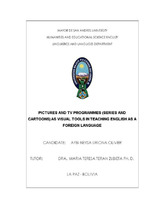Mostrar el registro sencillo del ítem
Pictures and tv programmes (series and cartoons) as visual tools in teaching english as a foreing languaje
| dc.contributor.author | Uriona Oliver, Aybi Neysa | |
| dc.contributor.author | Terán Zubieta, María Teresa (TUTORA) | |
| dc.date.accessioned | 2018-05-15T02:21:08Z | |
| dc.date.available | 2018-05-15T02:21:08Z | |
| dc.date.issued | 2012 | |
| dc.identifier.citation | Lenguas extranjeras, Inglés | es_ES |
| dc.identifier.uri | http://repositorio.umsa.bo/xmlui/handle/123456789/15884 | |
| dc.description.abstract | The interaction of Bolivia with the rest of the world inside the globalisationprocess requires the knowledge of English as a foreign language in order not only to communicate but also to understand the quick advance of technology. In our society, we are all living in a process of fast changes, especially in the technological one. Our country itself is facing the necessity of getting modifications and transformations not only in the political, economic, and social, areas, but also in the technological and educational process.For that reason, everybody needs help on both fields: English and technology for understanding better the rapid advance of globalization.That is why, it is necessary that students in schools should start using technology and the English language as tools for learning and for being well prepared in the future. For example, they should take advantage of some TV programs that are in English trying to cover the subtitles to improve their listening. Nowadays, English has not only become a tool for communication but also an indispensable resource of knowledge because it is the most widely spoken language in the world and in many cases a compulsory language in lots of areas such as science, medicine, commerce and education. For example, the person who wants to be updated and well informed finds efficient material in English because many sources of information like the internet or written books are in English.Translated material takes longer to reach people who are not able to use English to get the information required. Therefore, there is a big need to provide students an opportunity to enhance their knowledge in learning English in schools. This is a tool that can help them, in the future, to be updated and have more opportunities in their professional life. It is well known that some English classes are big in number and teachers have to find different alternatives to reach students. An entertaining way for teaching English as a foreign language is to use pictures and TV programmes such as series and cartoons to help students to learn English in a more dynamic way. Besides, we as teachers can include printed material such as magazines, newspapers, flash cards, puppets, and cut outs thatfacilitate the teaching – learning process in a more dynamic way. Using this material we can get students involved in the learning process in a more amusing way. We should also be aware of the importance of motivating learners including accessible and more realistic material for all of them. This research ofnew alternatives could make the learning of a foreign language more entertaining. In the same way it would help teachers of any level to have a wide source of dynamic material that would facilitate the development of their classes. This could be a challengethat would allowdeveloping new techniquesto improve the teaching of English in schools in order to help students learn in a more enjoyable way. | es_ES |
| dc.language.iso | en | es_ES |
| dc.publisher | Universidad Mayor de San Andrés. Facultad de Humanidades y Ciencias de la Educación. Carrera de Lingüística e Idiomas | es_ES |
| dc.subject | INGLES - ENSEÑANZA | es_ES |
| dc.subject | INGLÉS - APRENDIZAJE | es_ES |
| dc.subject | EDUCACIÓN PRIMARIA | es_ES |
| dc.title | Pictures and tv programmes (series and cartoons) as visual tools in teaching english as a foreing languaje | es_ES |
| dc.type | Thesis | es_ES |

